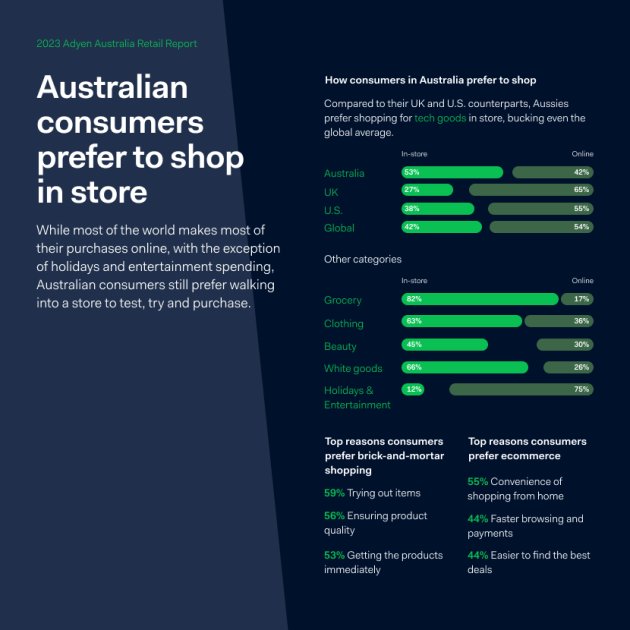Global financial technology platform Adyen has published economic research identifying the changing expectations of Australian consumers, finding that as the cost of living rises, personalisation and loyalty have become increasingly important.
Adyen commissioned Opinium LLP to poll 36,000 consumers, and Censuswide to poll 12,000 merchants globally, including 1000 Australian adults and 514 Australian businesses, to understand how inflation was affecting behaviour change among shoppers, and how businesses are adapting to this change.
In Australia, over 62 per cent of consumers want to see more discounting at retailers they shop with and 43 per cent say they want businesses to remember their preferences and previous shopping experiences so that browsing is more tailored. Retailers are finding it hard to deliver on this, with 44 per cent suggesting it’s now harder to categorise customers.
The tech advantage
More than half (62 per cent) of consumers say that they’d be more loyal to retailers that let them buy online and return in-store, and 40 per cent suggested they’d have better shopping experiences if a business enabled them to shop in store and finish online or vice versa.
When consumers were asked about how technology makes them feel when shopping in-store, the result is positive, 43 per cent said they were happier because shopping was quicker, and 19 per cent said they would visit a store more frequently as a result of its technology implementation.
Despite the findings, the business research uncovered just 20 per cent of businesses in Australia have already invested in unified commerce. This compares to 32 per cent beginning to invest and 36 per cent in the consideration phase.
Adyen country manager Australia and New Zealand Hayley Fisher said retailers would compete more for every dollar in the face of macroeconomic headwinds, but there were still clear opportunities.
“While consumers in Australia are willing to put in the work to find the best value, they aren’t just motivated by price – they’re looking for convenience, for personalisation, and businesses using this data to provide channel-agnostic, tailored experiences will have a definite edge.”
T2 Tea global director commercial Cat Parker said T2’s payment strategy was centered around unified commerce and having a single view of payments.
“Customers are running a million miles an hour and our job is to keep up with their expectations. Working with clean first party data informs all of our decision-making for what we're doing. It also helps us understand more about the behavior of our loyalty members versus non-members.
“As we integrate all of our payment methods into the same payment platform, we have a single view of all the payment transactions across different channels. Unified commerce enables our consumers to shop how they want and when they want. If we reward our customers with a really great experience, they’ll give us their loyalty and patronage,” said Parker.

Navigating shopper fraud
With the ongoing digital transformation of the retail sector, shopping experiences are evolving to become more inventive, varied, and refined. However, so too is the incidence of fraud.
During the last year, about 39 per cent of retailers experienced increased payment fraud attempts which is an increase from 2022 (35 per cent), losing an average of AU$274.9 each. More than a third (33 per cent) experienced cyberattacks or data leaks.
Despite the increase in fraudulent incidence, Australian shoppers are undertaking various techniques to minimise fraud risk with 40 per cent of consumers checking whether a website is secure before purchasing, and 31 per cent avoid saving their payment details for security concerns.
Microsoft director (global fraud risk lead), Aurélie Saada said, “The challenge for every organization is deciding where to set the threshold between the number of checks and controls to manage your fraud risk, versus the happiness of your customer as they go through a smooth payments journey. We spend a lot of time assessing how strict we want our risk tools to be.”
Socially conscious consumers
There is growing awareness of global issues such as climate change, social inequality, and environmental degradation, which have led many shoppers to re-evaluate their consumption habits and the impact they have on the planet.
More than half (58 per cent) of consumers said that they would spend more to ensure their purchase was carbon neutral, 66 per cent of consumers would spend more with restaurants or grocers that source their products sustainably and 33 per cent of consumers won’t shop with a retailer if they are aware of ethical issues in their supply chain.
Fisher said that the best businesses are those that not only succeed financially but also those that make a positive impact on the world.
“By embracing sustainability and social responsibility, retailers can differentiate themselves in a crowded market, build long-lasting relationships with customers, and contribute to a better future for everyone. We're proud to empower Australian businesses and consumers to use our technology to do good,” said Fisher.






